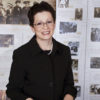Early Inventors – Women in History

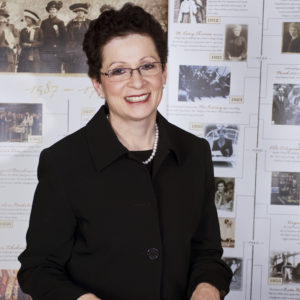
Jill S. Tietjen, PE, is an author, national speaker, and…
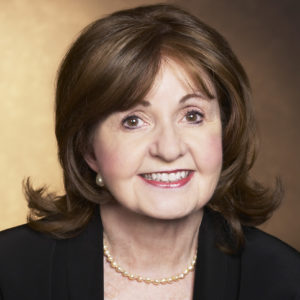
Charlotte S. Waisman, Ph.D. is a national champion and advocate…
We have written about women inventors before but there are always new ones whose stories we would like to share. In this month’s column, enjoy reading about women some of whose inventions we use every day.
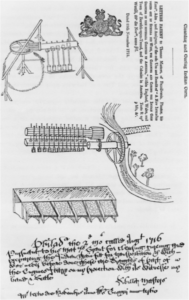
Masters Patent for Cleaning and Curing Corn
Sybilla Masters’ husband received two patents in his name for his wife’s inventions. These patents were issued in London, as the United States of America did not yet exist, and patents were not issued to women. These patents, given to “the Colonies” which is what the U.S. was called at the time, are believed to be the first patents so granted. In 1715, Sybilla patented a method of crushing corn at the gristmill she and her husband owned. Masters is believed to have developed the process after she watched Tuscarora Indian women beat corn with a pestle in large bowls. Her 1715 patent was titled “Cleansing Curing and Refining of Indian Corn Growing in the Plantations”. Masters was also an entrepreneur and sold her “Tuscarora Rice” in Philadelphia, where she lived. The second patent issued to Thomas Masters was for “Working and Weaving in a New Method, Palmetta Chip and Straw for Hats and Bonnets and other Improvements of that Ware.” This was a new way of working and staining straw and palmetto leaf to produce women’s bonnets using materials found in the New World. Masters marketed her patented hats “against Catherine Street in the Strand (London).”
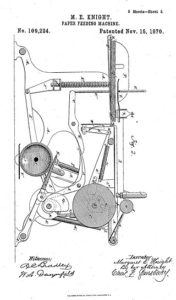
Patent for Improvement in paper-feeding machines
Itinerant inventor Margaret Knight spent years perfecting the machine that folds square bottom paper bags – the grocery bag. Defending her patent before the Commissioner of Patents against claims of a man who said it was his idea, she demonstrated knowledge and persistence and won her case – and her patent (1870). The paper-folding machine that resulted in grocery bags was her first issued patent. She conceived of the idea in 1867. She first attached her guide finger and plate-knife folder to paper-bag machines at a shop where she was employed in Springfield, Massachusetts. Satisfied with the results, she constructed a full-scale wooden model. She made the model drawings to have an iron model made by a skilled machinist and filed her patent paperwork. Knight has been described by some as a “female Edison: as she holds patents on some twenty-six items. Knight’s other patents ranged from projects domestic in nature to heavy machinery. Some of those patents included a dress and skirt shield (1883), a clasp for holding robes (1884), a spit (1885), a series of patents for shoe-cutting machines, and a series of patents for rotary engines and motors.
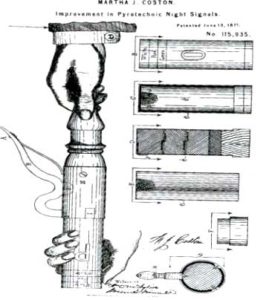
Martha Coston’s interest was in an area considered “highly unfeminine.” Coston was a widow with four children. She needed to support her family and she found the idea of making flares in her inventor-husband’s notebooks, after he had died. She was determined to make a signal flare. Signal flares were hard to make; they had to be both durable and simple and they had to last for a long time. In the mid-1800s, to make a flare required gunpowder, chemicals, pyrotechnics, as well as the ignition apparatus. Martha Coston’s green, red and white signal flares worked so well that the navy bought them from her for $20,000, an astounding amount of money at that time. Coston flares were used during the Civil War battle between the Monitor and the Merrimack. Martha Coston received her patent for this flare in 1871. She was inducted into the National Inventors Hall of Fame in 2006.
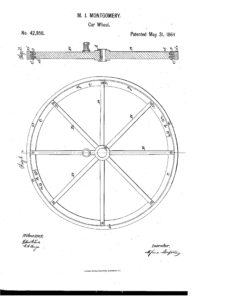
Inventor Mary Jane Montgomery received a patent in 1864 for improved locomotive wheels. In 1903, she is called the only professional woman inventor in the country by Scientific American. She is known to have patented a war vessel (1864), a metal punch (1866), and a bridge (1868). The war vessel, also called an amphibious fortress, was described as follows: “a war vessel that can be taken apart and put together again in different shape on land to serve as a fort. All of the pieces of the ship are corrugated, and fit into each other, being held together by bolts.” It was one of 125 women’s patent models exhibited in the Cotton States and International Exposition in Atlanta in 1895.

An important figure in the carpet industry, Catherine Evans Whitener, received only a fifth-grade education. Her curiosity about a tufted bedspread that was a family heirloom resulted in her resurrecting a technique called ‘candle wicking’ when she was just 15 years old. That tufted bedspread led to mats and bathrobes and eventually the Evans Manufacturing Company (1917). By 1941, the bedspread industry which was centered in Dalton, Georgia employed 10,000 people and had sales of $25 million. Today, 90% of carpet produced uses tufting. In 2001, Whitener was named a Georgia Woman of Achievement.
These inventors, as well as many other women, almost all of whom we have not heard about nor learned about in school, are profiled in our book, Her Story: A Timeline of the Women Who Changed America. Help us by continuing to tell the stories of the women who came before us, on whose shoulders we all stand. Tell young women especially so they understand that they can dream BIG, and then make their dreams a reality.
Author: Jill Tietjen
Jill S. Tietjen, PE, is an author, national speaker, and an electrical engineer. After 40 years in the electric utility industry, her professional focus is now on women’s advocacy, worldwide. She blogs for The Huffington Post, speaks nationally on the accomplishments of women, nominates women for awards, and continues to write books (8 published to date), following in the footsteps of her bestselling and award-winning book, Her Story: A Timeline of the Women Who Changed America (written with Charlotte Waisman). She is a frequent keynote speaker as her positive energy and her ability to relate to the audience result in inspired and energized listeners. The recipient of many awards, her induction into the Colorado Women’s Hall of Fame in 2010 remains one of her most treasured.

Jill S. Tietjen, PE, is an author, national speaker, and an electrical engineer. After 40 years in the electric utility industry, her professional focus is now on women’s advocacy, worldwide. She blogs for The Huffington Post, speaks nationally on the accomplishments of women, nominates women for awards, and continues to write books (8 published to date), following in the footsteps of her bestselling and award-winning book, Her Story: A Timeline of the Women Who Changed America (written with Charlotte Waisman). She is a frequent keynote speaker as her positive energy and her ability to relate to the audience result in inspired and energized listeners. The recipient of many awards, her induction into the Colorado Women’s Hall of Fame in 2010 remains one of her most treasured.

Charlotte S. Waisman, Ph.D. is a national champion and advocate for women as a professor and keynote speaker. A corporate leader, executive coach, and facilitator, she conducts leadership workshops nationally.

